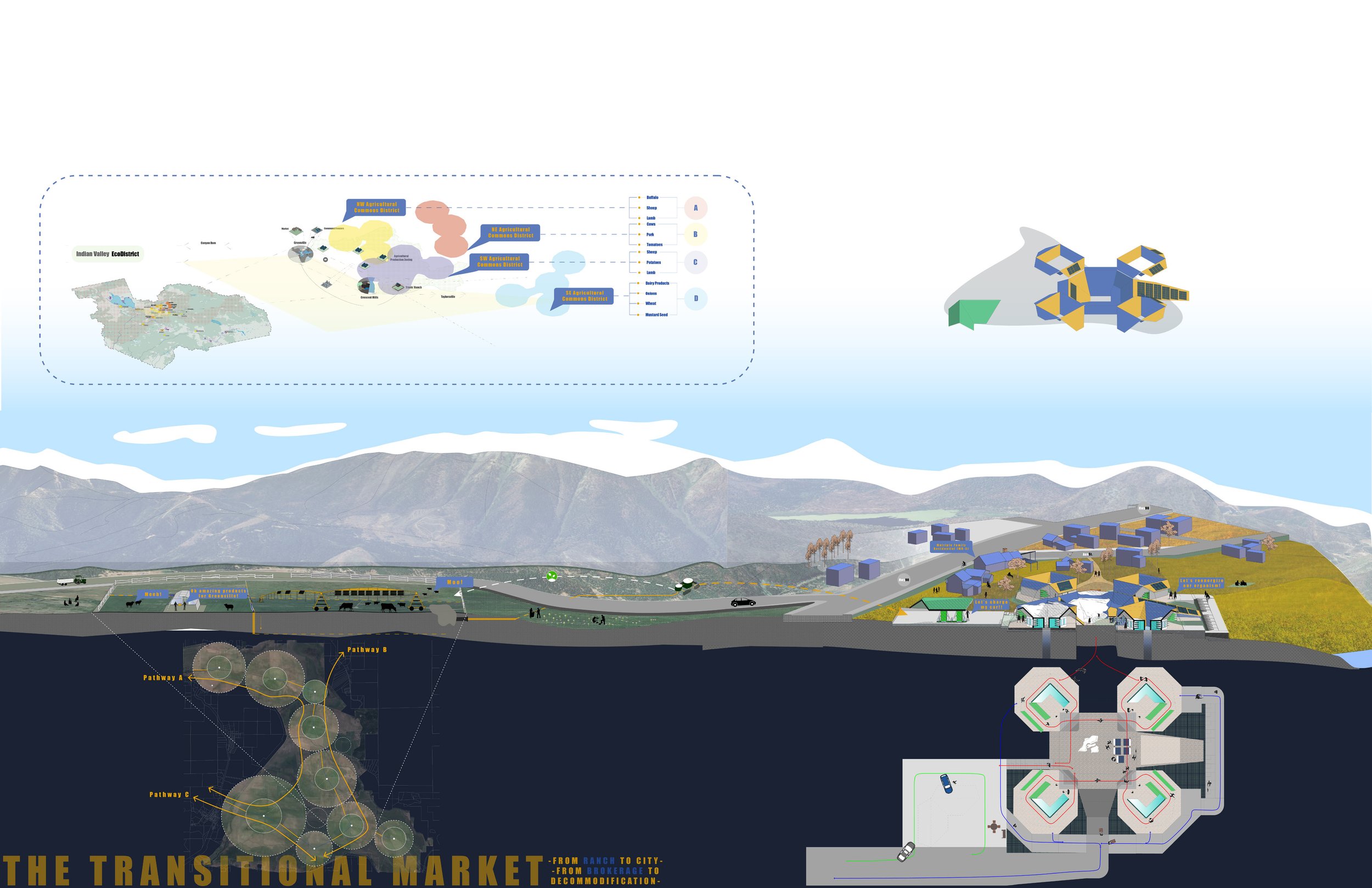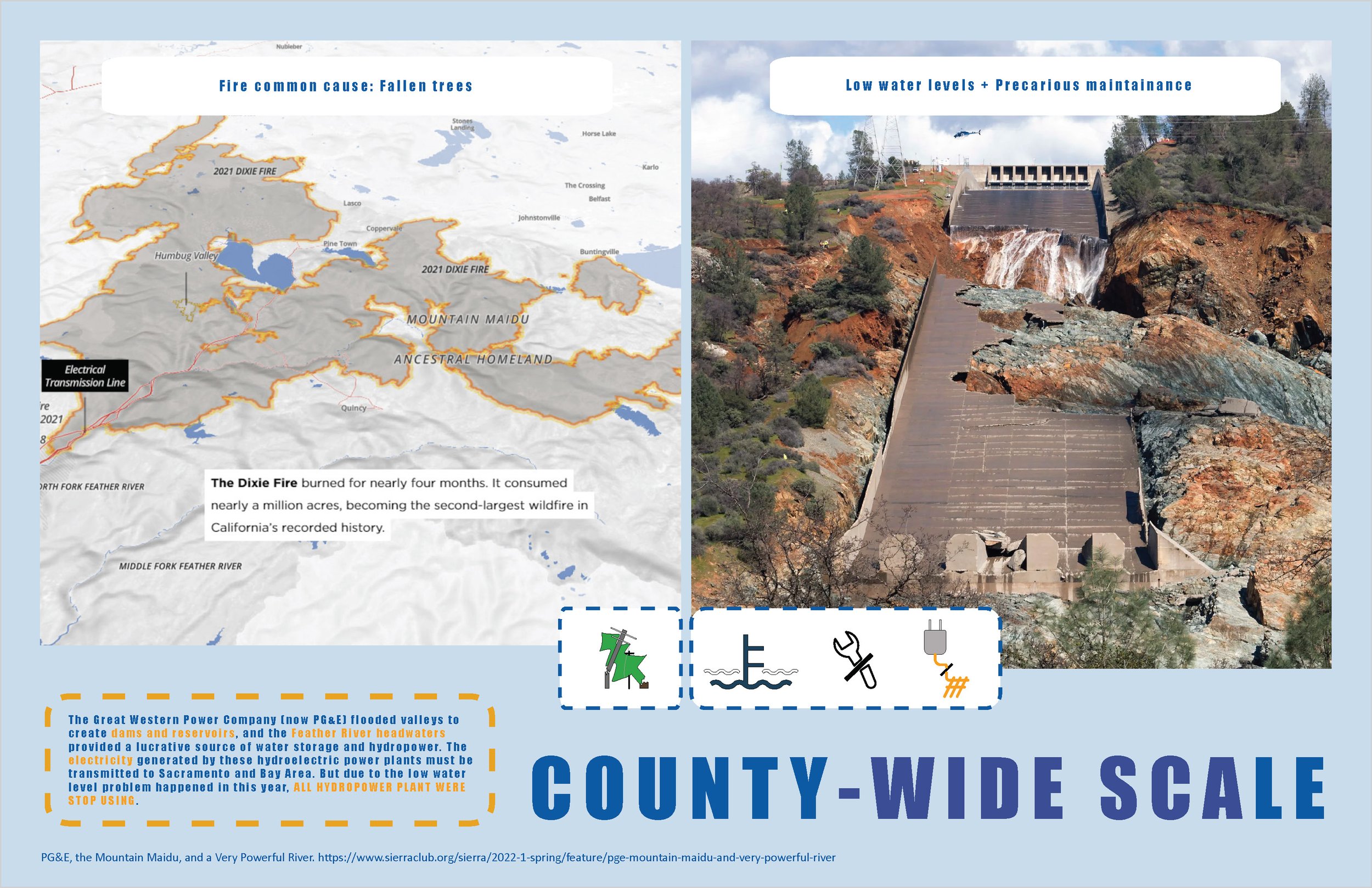THE TRANSITIONAL MARKET
ENERGY INFRASTRUCTURE + FOOD INDUSTRY
By Marcelo Miranda & Mason Chen
The food and ranching industry in California faces multiple issues like improper grazing techniques and food waste management. Nevertheless, regenerative ranching practices offer the possibility to transform these landscapes into a network of systems that not only prioritizes the production of clean energy but also protects Greenville’s resilient community and its valuable natural resources.

ENERGY INFRUSTRUCTURE
-

PROBLEMS & IDEAS
The Great Western Power Company (which we now know as PG&E) flooded valleys to create dams and reservoirs. They built all the power transmission lines to transfer the electricity generated by these hydroelectric power plants to Sacramento and the Bay Area. But due to the low water levels problem this year, ALL HYDROPOWER PLANTS WERE USELESS. During our visit to Greenville, residents talked thoroughly about the patchy infrastructure system that holds them from their everyday labor. Thus, connecting sustainable ranching practices with solar farms can generate higher economic profits for the ranchers and Greenville residents.
-

However, PG&E’s power stairway is not the only issue we are facing. Currently, an unfair systematic problem takes place within the ranching industry. Despite the fact that animal-food products have fluctuated in the market, beef value specifically has gone up about 50%, only to benefit the big four corporations, but not the neglected ranchers around the US. This is why, since the start of this century, more than 140,000 ranchers have gone out of business nationally. In order for us to connect our topics of interest and mitigate the damages from the current energy grid and the exploitative market, our project intends to rewrite how independence can be achieved by the whole community through the power harvest of California’s sunshine. By supporting local farmers and ranchers, our main purpose is to redirect the food supply chain so that the local economy can experience a growth in production that diversifies the food products and improves Greenville residents’ health.
FOOD INDUSTRY
It might seem like the energy infrastructure and food industry is not connected. However, they are. Here the Economic Flow Diagram explains it. The ranching plus electrical infrastructure can provide local and national-wide economic benefits to Greenville. We find out that solar farm is the best way to generate enough electricity for Greenville. Also, the shadows created by the solar panel can provide a comfort zone for cattle, sheep, and vegetables in the summer heat wave ( quick notes: according to the news provided by The Los Angeles Times, there are over 4000 cattle dead in the heat wave in CA this year.) In the local flow, we can see how solar systems generate electricity while Ranching can bring meat, vegetables, wool, etc., to Greenville. At the same time, As a result of Newsom’s proposed EV 2035 PLAN, all gasoline cars will be stopped by 2035 so that more tourists and residents will use electric cars. It is going to be important to build a charger station in that area.
Solar power provided by the ranches can generate enough power for Greenville, while the refrigerator serves the food freezing service to the farm and the frozen food to the residents. At the same time, the excess electricity is stored and provided to charging stations to offer fast charging services for tourists and residents. Also, the tourists brought by the charging stations can drive economic development to the ranches and Greenville. The local market can offer ranchers and farmers’ products to boost the local economy. This led us to decide that our final project was to design a Transitional Market.
FLOW DIAGRAM / PROGRAM
Our first step in the regeneration process for Greenville was to RE-INVENT the systems that were previously working to create bigger and stronger connections amongst the drivers of the food industry: the ranchers. Therefore we created new agro districts within the allowable zoning and took advantage of the proximity of the ranches to create a brokerage system where the local butchers act as mediators between Greenville’s downtown and the ranches. Thus RE-ASSEMBLING the whole communal spectrum and its economy.
We have redirected the food cold chain to minimize waste and create timely, efficient methods. A mobile slaughter unit can travel with the food products around the Agra district. Once the brokers have mobilized the products to the market, the retail spaces offer freezers to store these goods. The waste is sent to a Biothydro facility that converts the animal waste into energy through a biomass process. The animal’s leftover bone structure is fertilizer that goes back to the ranch to maintain healthy soil. Due to the proximity of the Ranches, we also designed spatial opportunities such as a solar shade pathway that acts as a large structure connected by both an irrigation and solar system that not only maintain the ranches but also provide some outdoor leisure to the adjacent residents.
RANCHER SYSTEM















